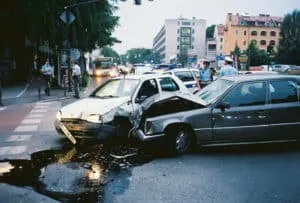There’s no denying that driving can be dangerous when adverse weather events come into play. This is especially treacherous when driving in the rain. According to the Federal Highway Administration (a branch of the U.S. Department of Transportation), 21% of all vehicle crashes are weather-related crashes. This accounts for approximately 1,235,000 crashes every year. More than 418,000 people are injured, and 5000 people are killed by these crashes annually.
While snow, sleet, ice, and fog are plenty to blame, most of these weather-related crashes can be attributed to rain. In fact, 70% of them are on wet pavements, and 46% happen during rainfall. This is because rain affects everything from visibility and pavement friction to lane obstruction.
Because of this, driving in the rain requires people to follow safety tips and take proper precautions. This article will discuss helpful safety tips for driving in the rain. Use these to keep yourself and others safe when on the road.
Safety Tips for Driving in the Rain in San Francisco
While you can try to avoid driving in the rain, it’s not always possible. Sometimes the weather is unrelenting, and you need to get to your desired location. However, it’s vital to avoid accidents and injuries by utilizing safety tips for driving in the rain when this is the case. Rainy weather should be taken seriously, and relevant precautions should be taken to avoid injury to yourself or those around you.
Driving in the rain becomes even more dangerous when considering how busy San Francisco’s roads can be. Car crashes are common enough without adding rain to the mix. With low visibility and all the other dangers that come with heavy rain, it’s crucial to ensure your safety by following Phoong Law’s tips for driving in the rain.
1. Keep a Safe Distance
You don’t need to be right behind another car. Leave enough space between yourself and other vehicles, so you have plenty of time to react if an incident occurs. Reaction times are slower in wet weather. This applies to both the car and to drivers. As such, keeping a safe distance is essential.
This is especially true when it comes to large buses or trucks. Because of their large tires, they can cause huge sprays that can further impact visibility. Keep your distance from large trucks and other large vehicles and avoid passing them. However, if necessary, ensure you pass them quickly while still remaining safe.
2. Drive Slowly
When driving in the rain, it’s essential to take your time. Instead of rushing, it’s necessary to drive slowly. Whether you encounter another car speeding, losing control, or a large puddle, the reduced speed will help you avoid collisions and car crashes that can leave you injured and liable for damages.
One estimate of the lack of friction in rainy and wet weather was one-third. Because of this, many experts suggest using the one-third rule of thumb when you’re unsure about speed. Think of how you’d regularly drive on the road and reduce that speed by one-third when it’s raining or in wet weather conditions. It should be noted that the one-third rule is just a guideline, and depending on the conditions, you may have to drive even more slowly.
3. Keep Your Headlights On
One of the most essential tips for driving in the rain is turning on your headlights. Since visibility is already low, other drivers must see you. However, don’t turn on your high beams. This can worsen visibility by blinding other drivers. The lights can reflect off of raindrops and distract you, making them more dangerous than helpful.
4. Know Good Braking Habits
In addition to braking with less pressure, it’s essential to brake earlier than you would normally. You must leave more space between yourself and the car in front of you, so you have more time to react in case things go awry. This usually is about three seconds in typical weather but should be stretched to five seconds in poor weather conditions. It’s also a good rule to follow since the vehicle behind you will know that you’re stopping since you’re braking with less pressure.
Additionally, hard braking can be detrimental when driving in the rain. It can lead to losing control of your car and end up damaging the brake system in your vehicle.
5. Don’t Use Cruise Control
Cruise control is a convenient feature in many vehicles. However, it’s only to be used in normal conditions and should be avoided when driving in the rain. In addition to distracting you and reducing your attention, it can also have devastating consequences if you hydroplane. If you end up hydroplaning, your car can accelerate, and you can lose control of your vehicle.
6. If There’s No Visibility, Pull Over
Sometimes, the rain is so heavy that it’s impossible to see anything. When there’s almost zero visibility, driving in the rain is reckless. Instead of putting yourself or others in danger, it’s better to find a safe spot to pull over and let the rainstorm pass. However, it’s vital to turn on your hazard lights when doing so. This way, other cars will see that you have pulled over to the side and won’t collide with you because of the visibility problems.
7. Know How to Avoid Hydroplaning and Skidding Accidents
Hydroplaning is one of the issues you must be aware of when driving in the rain. This occurs when your vehicle glides on top of the water, and either isn’t in contact with the ground or has minimal contact with the environment. Because there’s so little traction, any sudden movements can spell disaster. It’s important to know what to do in such a situation. If this ever happens, it’s critical to take your foot off the gas and remain calm. Then, you should steer in the direction you’re aiming for. It’s important to note that you shouldn’t steer until you regain traction.
Another issue faced by drivers is skidding. If your vehicle is skidding, you may have heard that you need to know where the skid originated before trying to resolve the issue. However, it’s enough to steer in the direction you want to turn. This is easier and saves valuable time when in a dangerous situation.
8. Avoid Running Water
You should always keep them in mind to avoid crossing through running water when it comes to rain driving tips. The water could be more profound than you think, and there’s a possibility that the sheer force can push your vehicle around. Even larger cars have been carried away in the current when they’ve underestimated running water, making it essential for drivers to take note of this.
9. Avoid Large Puddles
In addition to avoiding running water, it’s also essential to avoid large puddles. This tip is crucial whether changing your route or simply driving around the puddle because it’s difficult to tell how deep the puddle is. If it’s extremely deep, you may splash water into your vehicle’s electrical system. Alternatively, you could end up hitting a pothole that you didn’t know was there. Even causing splashes can be difficult when there’s already low visibility. It could put other drivers in danger and lower visibility further.
If you do end up going through large puddles, it’s a good idea to press the brake pedal very lightly after doing so. This may help dry rotors.
10. Use Your Windshield Wipers Properly
It’s not enough to simply use windshield wipers. They should be used at the correct speed to keep up with the volume of rainfall. Additionally, it’s your responsibility to ensure that your windshield wipers work correctly and are in good shape. Check them regularly to avoid any problems or surprises when driving in the rain.
11. Know That You’ll Encounter Slippery Roads
Preparation is key. Therefore, before you drive in the rain, you should be prepared for slick and slippery roads. Typically, roads see a build-up of substances like grease and engine oil. When it rains, these substances combine with water and make the roads slippery. Knowing what to expect can help you take the proper precautions, such as driving slowly.
12. Minimize Distractions
You need to focus more than usual when driving in the rain because of low visibility and slick roads. It’s critical to minimize distractions. Do not use your phone, even if you’re using the hands-free mode, because this is a potential distraction. Additionally, instead of listening to the radio, focus on the road so you can avoid any unfortunate accidents. Combine this with keeping both hands on the steering wheel constantly, so you’re always in control of your vehicle.
13. Use Your Defrosters
When driving in the rain, safety tips often don’t include using your defrosters. This is an essential tip to keep in mind since rain can cause your windshield to fog up and further obstruct your vision. Window defrosters are the key to avoiding this problem.
14. Prepare Your Car Adequately
You must maintain your vehicle so you can drive during rainy weather. This includes regularly keeping windshield wipers, turn signals, and headlights and taillights. Additionally, it’s essential to prepare and keep your tires. For example, you must replace tires when they start losing their tread.
An easy way to determine whether or not your tire needs to be replaced is by using a quarter. Place it upside down into the tire’s tread pattern and look at it. If you’re still able to see the top of Washington’s head, you need to replace your tires. In addition, to tread, it’s also essential to keep an eye on air pressure in tires. Another good rule of thumb is to rotate tires very 5000-6000 miles. However, this is just an estimate.
Driving in the Rain Safely Can Help You Avoid Legal Liability
With so much danger in driving in the rain, it’s usually best to wait until after the weather clears up. Heavy rain has caused many accidents and has taken lives. However, sometimes, there’s no other option possible, and you must drive during bad weather. In this case, it’s critical to follow safety tips for driving in the rain. Even things as simple as driving slowly, keeping your distance, and turning on your headlights can make a massive difference during these conditions. In addition to preventing life-threatening accidents, taking safety precautions can also afford you legal protection.
In heavy rain, it’s every person’s responsibility to drive safely. If you don’t follow safety tips for driving in the rain, you could be held responsible for damages incurred. For example, if you crash your car and hurt another driver, you could be liable for their injuries. To protect yourself legally, it’s good practice to follow rain driving tips.
If you, a friend, or a family member has been involved in an accident that took place when driving in the rain, you don’t have to be concerned. Legal representation is essential, and Phoong Law can take your case. You may have to defend yourself against personal injury charges – as experts in personal injury law with years of experience, we know the ins and outs of the field and can provide you with the representation you deserve. In fact, we’re the go-to personal injury law firm for many in Sacramento and San Francisco because of our reputation.
If you followed all safety tips for driving in the rain, but other drivers weren’t, and you’ve been in an accident, you deserve compensation. Their negligence can be proven, and whether it’s through a court of law or through an insurance claim, we can fight for you and get you your rightful compensation. You can call us via phone at (866) GOT-PAIN or schedule a free consultation – either way, we’ll be happy to discuss your case.
























